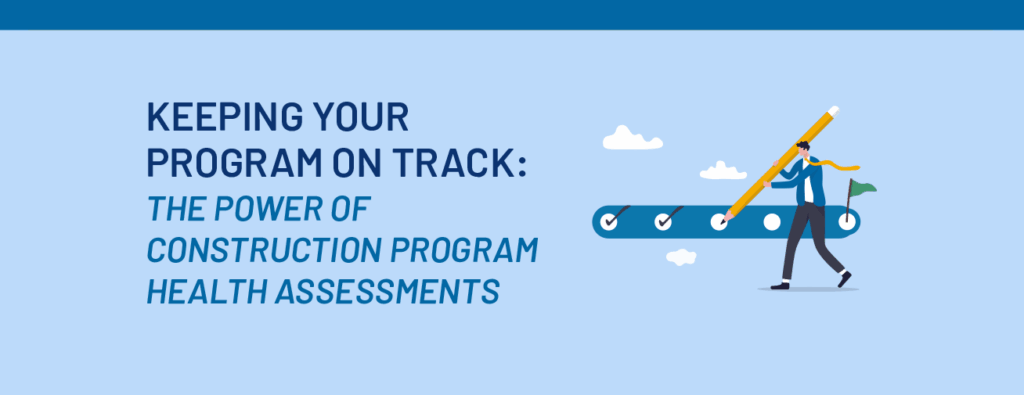
Large-scale programs are complex, high-visibility efforts that require careful management over multiple years. With aggressive schedules, evolving priorities, and multiple stakeholders, even the most well-planned programs can veer off course without the right checks and balances in place. That is where program health assessments come in—providing a structured, proactive approach to evaluating risks, identifying inefficiencies, and ensuring alignment before small issues become major roadblocks.
Much like routine medical check-ups catch potential health concerns early, regular program health assessments allow organizations to stay ahead of challenges, make data-driven decisions, and keep their programs running efficiently. But what exactly should these assessments look for, and how can they be embedded into the program management framework? Let’s take a closer look.
Why Are Health Assessments Essential?
Getting a program off to the right start is critical to long-term success, and program health assessments play a key role in that process. By conducting early evaluations, organizations can identify potential risks before they develop into major delays or cost overruns. Setting up regular checkpoints from the beginning helps prevent small inefficiencies from snowballing and supports proactive, informed decision-making.
Early assessments also ensure that program leaders are aligned with foundational goals from the outset. They help confirm that governance structures are well-designed, teams are set up for success, and execution strategies are appropriately matched to objectives. Establishing this clarity early on enables organizations to make timely adjustments and maintain momentum throughout the program lifecycle.
What Should a Program Health Assessment Evaluate?
A comprehensive health assessment should go beyond basic project tracking and dive into key areas that impact overall program performance. Governance and decision-making structures should be evaluated to ensure they support timely, informed choices. Cost and finance management must be analyzed to confirm that budgets are being established properly, tracked effectively, and that financial risks are mitigated.
Schedule performance is another critical factor—missed deadlines or frequent schedule adjustments could signal deeper coordination issues. Risk and change management processes should also be reviewed to ensure that teams are identifying and addressing risks proactively rather than reacting to them after they cause disruptions. Stakeholder engagement plays a crucial role as well, as misalignment among owners, contractors, and partners can lead to inefficiencies and project slowdowns.
Finally, procurement, contracting, and construction execution should be examined to ensure that vendor relationships are structured effectively, materials and resources are being allocated properly, and program teams are set up for a seamless transition to operations.
What is Included in a Health Assessment?
A health assessment is a comprehensive evaluation of key program areas, identifying strengths and areas for improvement, and providing a clear action plan for the future. Deliverables include a benchmark of program readiness against similar programs, an assessment of strengths and maturity in various areas, an implementation strategy, introduction of supporting technologies, and the development of key performance indicators, periodic evaluations, and process refinement (be on the lookout for my next blog, where I’ll go into key deliverables in more detail).
What Are the Warning Signs That a Program May Be Off Track?
Programs do not fail overnight. There are often early indicators that point to deeper structural or operational problems. Consistently missed deadlines, unexpected budget overruns, and unclear or shifting project scopes are all red flags that a program may be struggling. Poor stakeholder communication, lack of transparency, and an absence of structured risk management strategies can further contribute to inefficiencies and delays.
Additionally, contractor disputes and procurement challenges may indicate underlying contract structuring or vendor management issues. If program leaders frequently make reactive decisions rather than executing a well-planned strategy, it is a sign that processes may need to be adjusted to ensure smoother operations.
How Do Structured Assessments Help Leaders Take Action?
Instead of relying on assumptions or anecdotal feedback, structured health assessments provide concrete, data-driven insights that allow program leaders to make informed decisions. These assessments benchmark program performance against industry best practices and similar large-scale programs, providing a clear picture of where improvements are needed.
Program teams can identify areas of strength through structured evaluations and pinpoint specific weaknesses that require attention. Instead of waiting for major roadblocks to emerge, assessments allow organizations to course-correct proactively, ensuring that financial resources, staffing, and timelines remain aligned with program goals.
How Can Organizations Make Health Assessments a Standard Practice?
To truly benefit from program health assessments, organizations must go beyond one-time evaluations and integrate them into their ongoing program management strategy. Scheduling regular assessments at key project milestones allows teams to continuously monitor progress and make necessary adjustments.
Incorporating real-time data monitoring tools can also improve transparency, helping teams track key performance indicators (KPIs) and spot trends before they become larger issues. Open communication with stakeholders is equally important—by encouraging feedback from internal teams, partners, and contractors, organizations can quickly identify and resolve misalignment issues.
Most importantly, program leaders should embrace a culture of continuous improvement, where assessments are seen not as audits but as valuable opportunities to optimize processes, strengthen collaboration, and ensure long-term success.
Managing a large, multi-year program requires more than just tracking milestones and budgets. Without a structured process for evaluating performance and identifying risks, even the most well-planned programs can experience setbacks.
Health assessments provide a critical layer of oversight, helping teams stay ahead of challenges, improve efficiency, and maintain strategic alignment. By embedding these assessments into the broader program management framework, organizations can enhance decision-making, minimize risks, and drive better outcomes.
Download a copy of this blog here.



